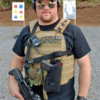Situational awareness is a serious concern for anyone carrying a firearm on their person for personal protection. We have a higher level of responsibility when we leave the house with the instantaneous ability to use deadly force. If we are not aware of what is going on in our surroundings we have an elevated risk of overreacting in a situation or not responding to a deadly threat appropriately.
Now lets look at why we carry firearms. As private citizens, our firearm exists for one purpose alone. That is to defend our life or the life of another from a deadly threat that is happening right now. If we have no situational awareness, how are we going to see a potential deadly threat before it happens? The answer is that we are not going to see it coming. A situation is going to blow up in our face as it is happening and we are going to have a lag in time from the time that we actually see the situation unfolding, decide that it is a threat and then try to respond accordingly. This is a disastrous situation for anyone to be in and this is where we see things go awry.
Situational awareness is more of a mindset than a hard skill, and anyone can develop this mindset with enough self-discipline. A great tool to help develop this mindset is the color code concept. The color code concept was originally developed by members of the 82nd airborne division in WWII, and was subsequently adopted by Jeff Cooper for personal defense in the 1960s. The color codes are broken into five levels of mental alertness, each identified by a “color”.
The first level is condition white. In this condition the person is not actively paying attention to their surroundings at all. The biggest cause of people being in this condition when they are out in town, in my opinion, is cell phones. We have all been in situations where we have seen this. People are so engulfed in their phones and social media apps that they are not paying attention to where they are even walking let alone who is around them and what is going on. In this level of mental alertness a person is not going to ever see an emerging threat coming, and subsequently they are not going to be able to effectively avoid that threat or respond appropriately. This is a potentially disastrous mindset to be in while outside of the home, especially for anyone carrying a firearm.
The next level is condition black. This condition often includes tunnel vision, auditory exclusion, and full sensory overload. People often end up in this condition when they are in condition white and a situation blows up in their face. Since the person had no way of seeing the situation coming, when it did unfold the person was not at all ready to respond and therefore moved into condition black. We can avoid going into condition black by staying out of condition white and paying attention to their surroundings.
The next condition is condition yellow. In this condition a person is calm and in control, but paying attention to their surroundings. They are not appearing hyper-vigilant or suspicious, yet they are keeping their head on a swivel and paying attention to their surroundings. This is the proper condition for a person to be in when outside the home, especially if they are carrying a firearm. In this condition a person would be able to recognize a potential threat and seek more information to decide if it was actually a threat.
The next condition is condition orange. In this condition a person has seen a potential threat and is seeking additional information to make that determination. We may see something that seems off and we are either moving away from the situation, or, if that is not an option we are looking for that additional information so that we may decide if it is a threat and we need to take action to defend our life.
The last condition is condition red. This is the condition that we would move into if we made the determination that there was in fact a threat and we had to take action to defend ourselves. This condition is the action you are taking to defend your life or the life of another. People can still experience tunnel vision, auditory exclusion, and full sensory overload in this condition so it is important to be scanning our surroundings to ensure that there are no other threats.
Developing situational awareness skills takes time and it takes practice, but we can do this in our everyday activities. The first step is to realize that threats do exist. Pay attention to the people around you and their demeanor. Always be scanning your immediate environment, and most importantly, if you are out and about it is advisable to leave the social media for home.


